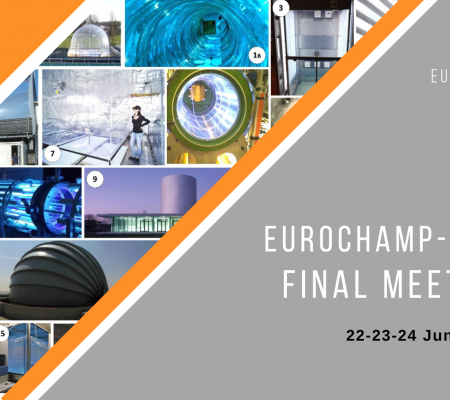| General information | |
| Access mode | Physical access: “hands-on” access to ENV chamber |
| Infrastructure name and acronym | PSI Atmospheric Chemistry Simulation Chambers (PACS-C3) |
| Photos |
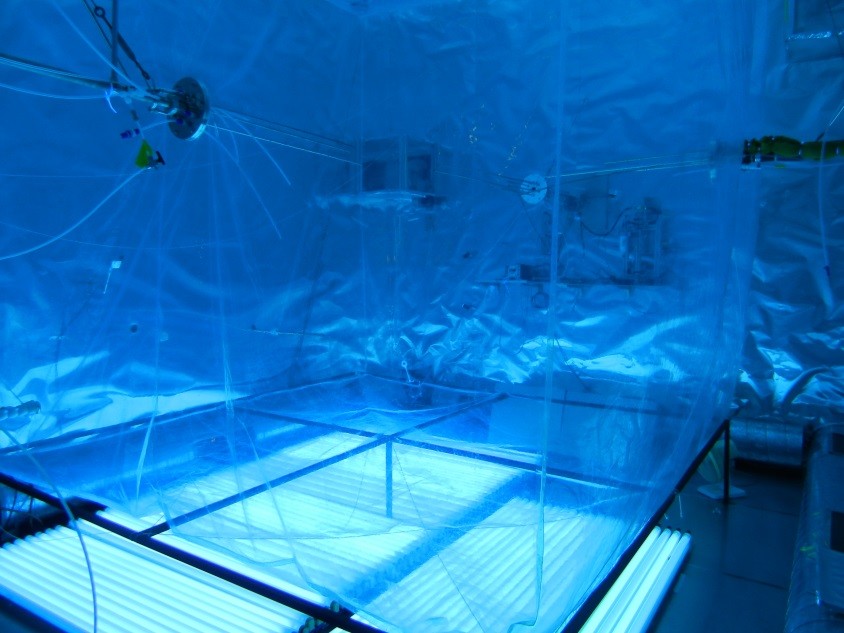 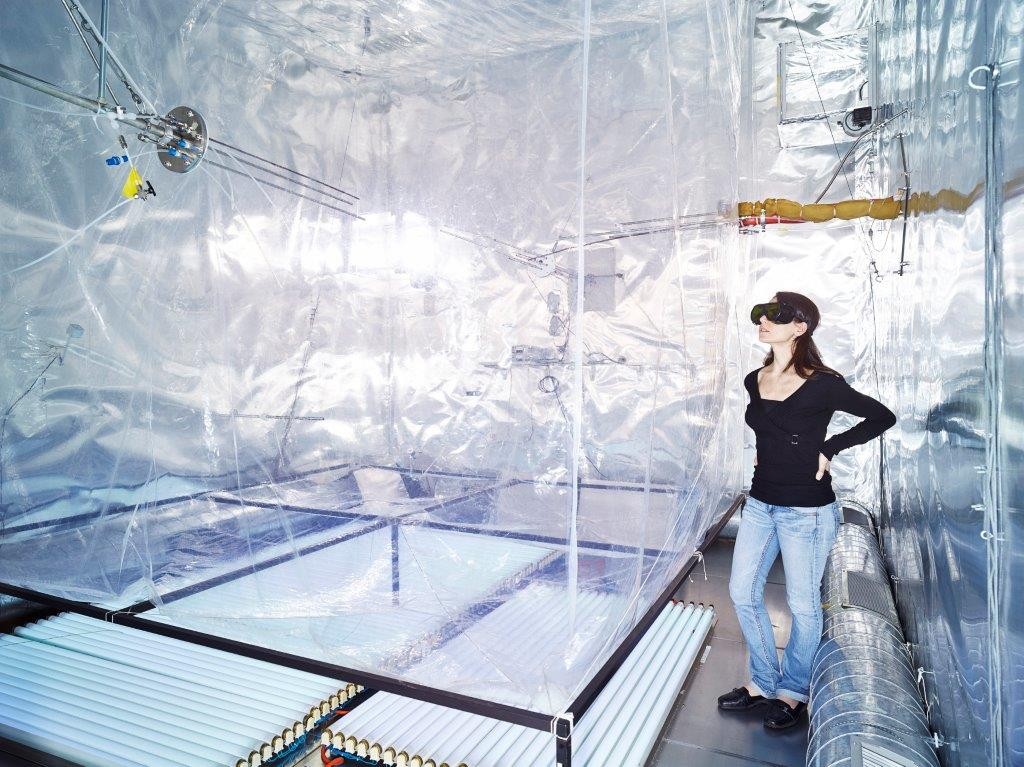 |
| Location | Villigen, Switzerland 47.538766, 8.228891 |
| Website | https://www.psi.ch/lac/smog-chamber |
| Legal name of organisation operating the infrastructure | Paul Scherrer Institut |
| Description of the infrastructure | |
| Brief general description of the infrastructure to which access is offered |
PACS-C3 consists of 3 different simulation chambers, a stationary 27 m3 chamber (air-conditioned at 15 to 30 °C), a mobile 9 m3 chamber (without own air condition), and a stationary 9 m3 cool chamber (air-conditioned between -10 to 30 °C).
The stationary big chamber has the advantage of a large air volume, which is important when many instruments sample for long times, such as for inter-comparison purposes. The mobile chamber can be brought to any emission source and is therefore especially suited to e.g. evaluate secondary organic aerosol (SOA) formation from test benches. The cool chamber is able to simulate SOA formation also at temperatures down to -10°C, which is especially relevant for wood burning emissions, which typically occur at low temperatures.
PSI has a full suite of state of the art instrumentation. Depending on the objectives of the campaign, the chambers can be equipped with the following instruments for gas phase characterization: a proton-transfer reaction time of flight mass spectrometer (PTR-TOF-MS), a chemical ionization atmospheric pressure interface time of flight MS (CI-APi-TOF), as well as the standard NOx and ozone monitors; for NO there is also a high sensitivity instrument (detection limit 5 ppt) available, important for experiments a low NOx conditions. For the characterization of the particle phase the following instrumentation is available: condensation particle counters with different lower cut-off sizes (3 and 10 nm), a particle size magnifier (PSM for even smaller particles, scanning mobility particle sizers (SMPS) for the size distribution (two different size ranges available with a nano and a standard SMPS), a high resolution time of flight aerosol mass spectrometer (TOF-AMS), extractive electrospray ionization time-of-flight mass spectrometer (EESI-ToF), an instrument for on-line determination or reactive oxygen species (ROS) and peroxides. In addition, a FIGAERO (Filter Inlet for Gas and Aerosols) coupled to a CI-APi-TOF is available for chemical speciation of gas and aerosol components. For black carbon measurements, a single particle soot photometer (SP2) and an aethalometer are available.
|
| Services currently offered by the infrastructure and its research environment |
Visiting scientists are invited to suggest state of the art research to be performed with any of our simulation chambers. In addition, visiting scientists are encouraged to join the PSI experiments according to the Work plan. |
| Modalities of access and support offered under EUROCHAMP-2020 | |
| Typical duration of work |
Around three weeks of access |
| Community/user type served |
Researchers interested in formation and aging of secondary organic aerosol, or characterization of black carbon. |
| Scientific and technical support offered | The very large suite of state of the art instrumentation at PACS-C3 will ensure that additional instruments brought in by the scientific visitors will provide the maximum benefit. Moreover, PSI offers specific calibration experiments for instruments measuring black carbon, where the black carbon core aerosols will be coated with varying amounts of scattering material. |
| Logistic and administrative support offered |
Guest house available for cost effective accommodation. Technical support in setting up of instrumentation. |
| Person in charge of access provision at the infrastructure | Prof. Urs Baltensperger, Laboratory Head, urs.baltensperger@psi.ch |
| Extended technical information | |
| Physical description |
Large Smog Chamber: The chamber is a 27m3 (3×3×3 m) flexible bag made of 125 μm Teflon® fluorocarbon film (FEP). The bag is suspended in a temperature controlled wooden enclosure having dimension 4×5×4 m (L×W×H). Temperature can be stabilized to 1°C within the range of 17 to 25 °C. Four xenon arc lamps and/or a bank of 80 black lights can be used as light source. The surface-to-volume ratio of the chamber is 2 m2 / m3 and the chamber can be operated at ambient to slightly above pressures. Aerosol lifetimes in the large chamber can be as long as 12 – 15 hours. JNO2 for this chamber is 1.6 x 10-3 sec-1. Its projected surface area is of 9 m².
Cool Chamber & Mobile Smog Chamber: It consists of 9m3 Teflon bag hung on an aluminum frame together with a battery of 40 100W UV lights (Ergoline, Cleo Performance solarium lamps). Connected to the chamber is a separable control unit consisting of a pure air generation system (737-250 series, AADCO Instruments, Inc., USA) and inlet lines for gaseous components (NO, NO2, O3, H2O, organic compounds). All of these units may be mounted on a trailer for transport or ambient studies, or dismounted and deployed in various configurations. The surface-to-volume ratio of these chambers is 3.2 m2 / m3 and can be operated at ambient to slightly above pressures. The JNO2 values for the chambers is: 3 x 10-3 sec-1. Aerosol lifetimes in these chambers is usually ~3-5 hours. Its projected surface area is of 4-5 m².
Relative humidity in the mobile chamber can be adjusted rapidly and accurately to anywhere between 0-95%. When operated independently of the transport trailer, the temperature is determined by the capabilities of the host facility; experiments have so far been conducted in the range -10 to 30 °C.
|
| Mechanical description (Large Chamber) | 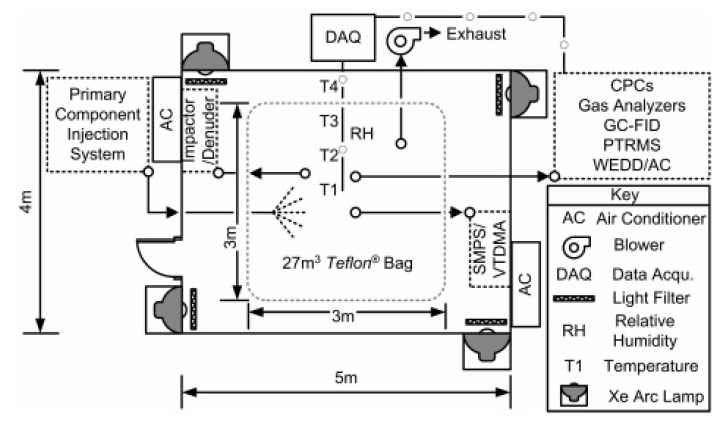 Taken from description paper, DOI: 10.1021/es0489137 |
| Mechanical description (Mobile & Cool chamber) | 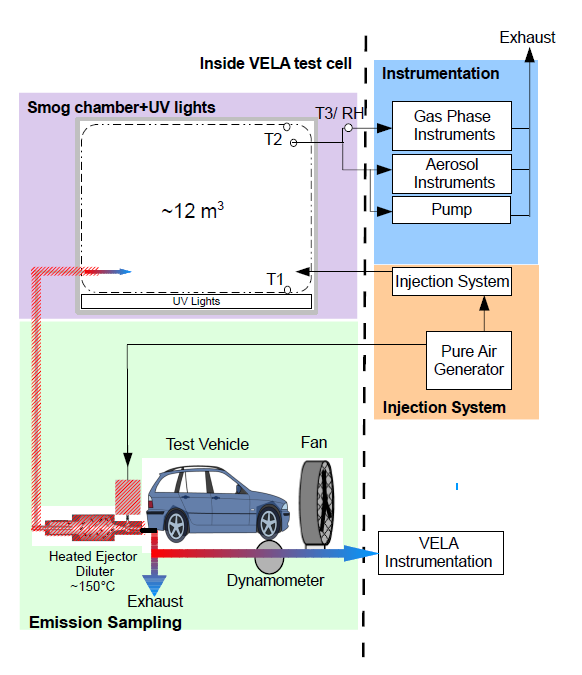 Taken from description paper, DOI: 10.5194/acp-13-9141-2013 |
| Irradiation spectra |
Large Smog Chamber:
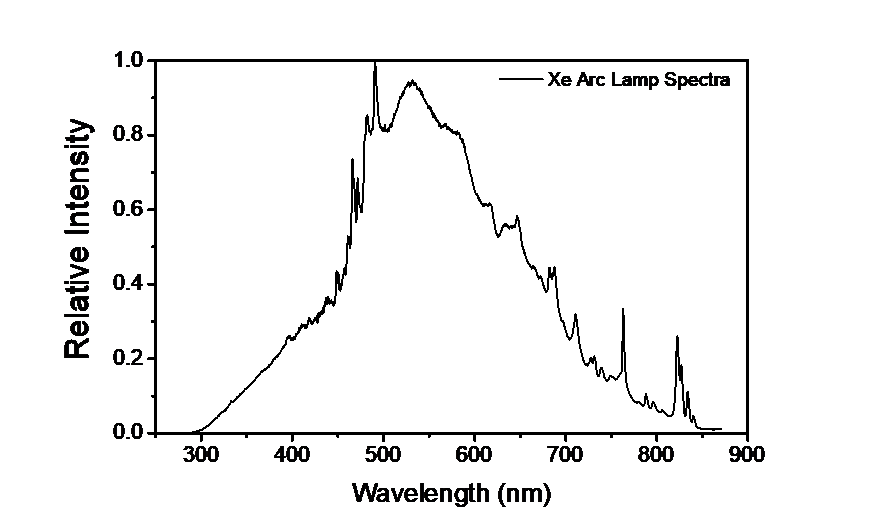
Mobile & Cool Chamber:
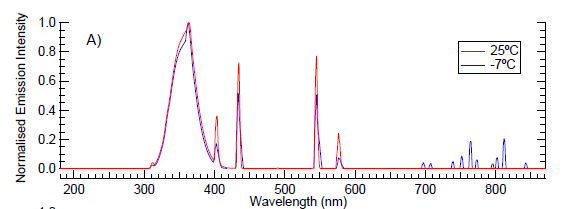 Taken from description paper, DOI: 10.5194/acp-13-9141-2013
|
| Auxiliary mechanism |
hν + wall à HONO (g) 9.1 x 106 molecules cm-3 sec-1 NO2(g) à 0.5 HONO (g) + 0.5 HNO3 (wall) 0.53 x 10-6 sec-1 hν + wall à HCHO (g) 5 x 106 molecule cm-3 sec -1 N2O5 (g) à 2 HNO3 (wall) 1 x 10-20 cm3 sec -1 O3 (g) à O3 (wall) 4 x 10-6 sec-1 HNO3 (g) à HNO3 (wall) 1 x 10-4 sec-1 HNO3 (wall) + hν à NO2 (g) + OH (g) JHNO3 NO2 (g) + hν + wall à HONO 8.4 x 10-6 sec-1 Taken from DOI: 10.5194/acp-8-6453-2008 |
| Description paper |
Large Smog Chamber: Dwane Paulsen, Josef Dommen, Markus Kalberer, André S. H. Prévôt, René Richter, Mirjam Sax, Martin Steinbacher, Ernest Weingartner, and Urs Baltensperger. Secondary organic aerosol formation by irradiation of 1, 3,5-trimethylbenzene-NOx-H2O in a new reaction chamber for atmospheric chemistry and physics. Environ. Sci. Technol. 39,2668–2678 (2005). DOI: 10.1021/es0489137 Metzger, A., Dommen, J., Gaeggeler, K., Duplissy, J., Prevot, A. S. H., Kleffmann, J., Elshorbany, Y., Wisthaler, A., and Baltensperger, U.: Evaluation of 1,3,5 trimethylbenzene degradation in the detailed tropospheric chemistry mechanism, MCMv3.1, using environmental chamber data, Atmos. Chem. Phys., 8, 6453-6468, 2008 DOI : 10.5194/acp-8-6453-2008
Mobile Smog Chamber / Cool Chamber :
Platt, S. M., El Haddad, I., Zardini, A. A., Clairotte, M., Astorga, C., Wolf, R., Slowik, J. G., Temime-Roussel, B., Marchand, N., Ježek, I., Drinovec, L., Močnik, G., Möhler, O., Richter, R., Barmet, P., Bianchi, F., Baltensperger, U., and Prévôt, A. S. H.: Secondary organic aerosol formation from gasoline vehicle emissions in a new mobile environmental reaction chamber, Atmos. Chem. Phys., 13, 9141-9158, 2013 DOI : 10.5194/acp-13-9141-2013 |



